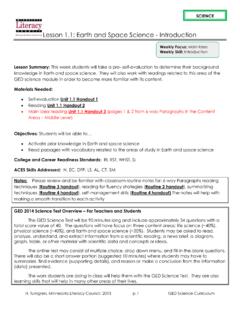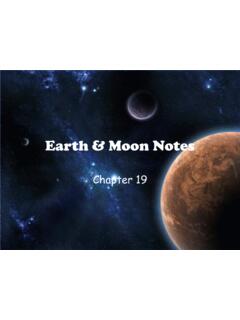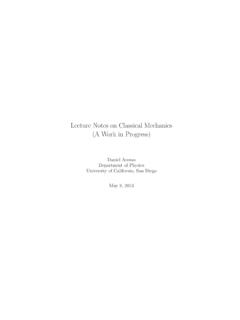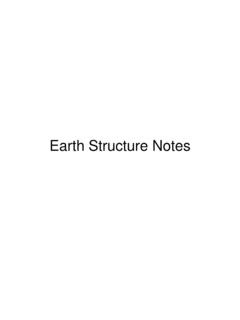Transcription of Lecture Notes in Oceanography - ttu.ee
1 Lecture Notes in Oceanography by Matthias Tomczak Flinders University, Adelaide, Australia School of Chemistry, Physics & earth sciences ~mattom/ 1996-2000 Lecture Notes in Oceanography by Matthias Tomczak 2 Contents Introduction: an opening Lecture General aims and objectives Specific syllabus objectives Convection Eddies Waves Qualitative description and quantitative science The concept of cycles and budgets The Water Cycle The Water Budget The Water Flux Budget The Salt Cycle Elements of the Salt Flux Budget The Nutrient Cycle The Carbon Cycle Lecture 1. The place of physical Oceanography in science; tools and prerequisites: projections, ocean topography The place of physical Oceanography in science The study object of physical Oceanography Tools and prerequisites for physical Oceanography Projections Topographic features of the oceans Scales of graphs Lecture 2.
2 Objects of study in Physical Oceanography The geographical and atmospheric framework Lecture 3. Properties of seawater The Concept of Salinity Electrical Conductivity Density Lecture 4. The Global Oceanic Heat Budget Heat Budget Inputs Solar radiation Heat Budget Outputs Back Radiation Direct (Sensible) Heat Transfer Between Ocean and Atmosphere Evaporative Heat Transfer The Oceanic Mass Budget Lecture 5. Distribution of temperature and salinity with depth; the density stratification Acoustic Properties Sound propagation Nutrients, oxygen and growth-limiting trace metals in the ocean Lecture 6. Aspects of Geophysical Fluid Dynamics Classification of forces for Oceanography Newton's Second Law in Oceanography ("Equation of Motion") Inertial motion Geostrophic flow The Ekman Layer Lecture Notes in Oceanography by Matthias Tomczak 3 Upwelling Lecture 7.
3 Thermohaline processes; water mass formation; the seasonal thermocline Circulation in Mediterranean Seas Lecture 8. The ocean and climate El Ni o and the Southern Oscillation (ENSO) Lecture 9. Waves Wave Classification Description of Waves Normal dispersion Nondispersive waves Anomalous dispersion Waves of finite amplitude Short waves (deep water waves) Statistical description of waves Lecture 10. Long Waves (shallow water waves) Tsunamis Seiches Internal Waves Lecture 11. Tides Description of tides The Tide-Generating Forces Main tidal periods Tidal Classification Shape of the Tidal Wave Co-oscillation tides Lecture 12. Estuaries Salt wedge estuary Highly stratified estuary Slightly stratified estuary Vertically mixed estuary Inverse estuaries Intermittent estuaries Lecture 13. Oceanographic instrumentation Platforms Research vessels Moorings Satellites Submersibles Towed vehicles Floats and drifters Measurements of hydrographic properties Reversing thermometers Nansen and Niskin bottles CTDs Multiple water sample devices Thermosalinographs Remote sensors Measurements of dynamic properties Current meters Lecture Notes in Oceanography by Matthias Tomczak 4 Wave measurements Tide gauges Remote sensors Shear probes Lecture Notes in Oceanography by Matthias Tomczak 5 Introduction: an opening Lecture For many years the Flinders University of South Australia has offered a first year topic earth sciences in two parts.
4 The first semester topic, earth sciences 1A, covered the place of the earth in the universe, aspects of geology, and an introduction into geophysics and hydrology. Meteorology and Oceanography were covered in the second semester topic earth sciences 1B. Beginning in 2000 the two topics are delivered as earth sciences 1, which continues as the first semester topic with identical content, and Marine sciences 1 as the second semester topic. Marine sciences 1 still contains extensive material on meteorology and physical Oceanography but also contains an elementary introduction to aspects of marine biology. These Notes represent the topic content for physical Oceanography . In addition, two introductory lectures place the atmospheric and oceanographic aspects of the topic in the context of the exact sciences ; they are an abbreviated version of the first two lectures given at the beginning of the semester.
5 General aims and objectives To give students practical experience in general scientific methodology including laboratory and field-based experimentation and scientific report writing. To help students develop an understanding of the unifying principles and processes which are critical in understanding both the evolution and behaviour of the planet earth , with a particular focus on aspects relating to the atmosphere and the ocean. To encourage critical thinking and assist in the development of both quantitative and qualitative problem solving skills. To assist in the development of communication and team work skills in a technical environment. Specific syllabus objectives To provide an overview of the processes which determine the state of the atmosphere and the ocean and their dynamics.
6 To describe our planetary environment and the governing cycles and processes which control its behaviour. To describe the processes and phenomena which directly affect the nature and behaviour of the "fluid" earth , namely, the composition of the atmosphere and of seawater, the balance of forces which controls winds, ocean currents and waves in both media, and their role in climate. To describe the natural atmospheric and oceanic processes which impact on use of the earth 's resources including industrial, commercial and recreational use and conservation. To let students appreciate the importance of scientific understanding of physical processes in ocean and atmosphere and the forces behind them for environmental pollution and management problems. What will we learn today? 1. The environment earth is shaped by the presence of life.
7 2. Understanding the environment means understanding the interaction between biosphere, geosphere, hydrosphere and atmosphere. Lecture Notes in Oceanography by Matthias Tomczak 6 3. earth sciences study the three non-living components of this interactive system. 4. Geosphere, hydrosphere and atmosphere are fluids in motion; their main difference is their viscosity. 5. As fluids in motion they exhibit some common features. Examples are convection, eddies, and energy transport through wave propagation. The sciences of meteorology and Oceanography study the results of these processes in the atmosphere and in the ocean. The living and non-living components of the interactive system earth are shaped through interaction - even the structure of its non-living components is determined by the presence of life.
8 This is most pronounced for the atmosphere; its composition is determined by the presence of life. In the absence of life the most important gas in the atmosphere is carbon dioxyde (CO2) which makes the atmosphere toxic for higher life forms. Life on earth evolved through the activity of bacteria which reduced CO2 levels to tolerable concentrations and produced oxygen (O2) in the process. Examples for this planetary state are Venus and Mars; both have an atmosphere with a CO2 content of 95%. The present make-up of earth 's atmosphere is maintained by continuous interplay between reduction of CO2 and production of O2 by plants and reduction of O2 and production of CO2 by animals and humans. Without the presence of life the atmosphere would not maintain its composition.
9 The earth 's atmosphere is therefore said to be in "dynamic equilibrium", while in the absence of life atmospheres are said to be in "dead equilibrium". In the 1960s the British chemist James Lovelock was engaged by the space agency NASA of the USA in its search for extra-terrestrial life, particularly on Mars and Venus. Noticing the large difference in atmospheric composition between earth and the other two planets - and in particular the fact that the atmospheres of Venus and Mars are in a dead equilibrium while the atmosphere of earth is in a dynamic equilibrium, which without life would immediately revert to the dead equilibrium - he and Lynn Margulis, a microbiologist from the USA, developed the gaea concept or hypothesis. They point out that the presence of life has far reaching consequences for the planet as a whole.
10 The development of forest, for example, reduces the Lecture Notes in Oceanography by Matthias Tomczak 7 albedo (the reflectivity of the earth 's surface) considerably. As a result the earth is several degrees warmer than it would be without the presence of life. The gaea hypothesis therefore states that the planet earth is a living organism itself, and oceans, land, air and all lifeforms are different organs of a living body. Whether one accepts the gaea hypothesis in its extreme formulation or not, it is beyond doubt that the gaea hypothesis is a scientific hypothesis and can withstand the many attempts to turn it into a "new age religion". The fact remains that earth as it is today is determined in its physical state (the distribution of water and ice, the composition of the atmosphere, the weathering processes of rocks, and much more) by the presence of life.









